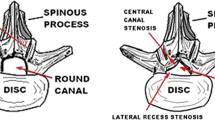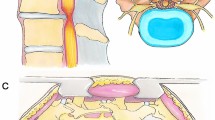Abstract
A number of interspinous process devices have recently been introduced to the lumbar spinal market as an alternative to conventional surgical procedures in the treatment of symptomatic lumbar stenosis. One of those “dynamic” devices is the Coflex™ device which has been already implanted worldwide more than 14,000 times. The aim of implanting this interspinous device is to unload the facet joints, restore foraminal height and provide stability in order to improve the clinical outcome of surgery. Published information is limited, and there are so far no data of comparison between the implant and traditional surgical approaches such as laminotomy. The purpose of our prospective study is to evaluate the surgical outcome of decompressive surgery in comparison to decompressive surgery and additional implantation of the Coflex™ interspinous Device. 60 patients who were all treated in the Spine Center of Klinikum Neustadt, Germany for a one or two level symptomatic LSS with decompressive surgery were included. Two groups were built. In Group one (UD) we treated 30 patients with decompression surgery alone and group two (CO) in 30 patients a Coflex™ device was additional implanted. Pre- and postoperatively disability and pain scores were measured using the Oswestry disability index (ODI), the Roland–Morris score (RMS), the visual analogue scale (VAS) and the pain-free walking distance (WD). Patients underwent postoperative assessments 3, 6 and 12 month including the above-mentioned scores as well as patient satisfaction. In both groups we could see a significant improve (p < 0.001) in the clinical outcome assessed in the ODI, in the RMS for evaluation of back pain, in the VAS and in the pain-free WD at all times of reinvestigation compared to base line. At 1-year follow up there were no statistically differences between both groups in all ascertained parameters including patient satisfaction and subjective operation decision. Because there is no current evidence of the efficacy of the Coflex™ device we need further data from randomized controlled studies for defining the indications for theses procedures. To the best of our knowledge this is the first prospective controlled study which compares surgical decompression of lumbar spinal stenosis with additional implanting of an interspinous Coflex™ device in the treatment of symptomatic LSS.







Similar content being viewed by others
References
Anjarwalla NK, Brown LC, McGregor AH (2007) The outcome of spinal decompression surgery 5 years on. Eur Spine J 16:1842–1847
Atlas SJ, Keller RB, Wu YA et al (2005) Long-term outcomes of surgical and nonsurgical management of lumbar spinal stenosis: 8 to 10 year results from the maine lumbar spine study. Spine 30:936–943
Bertagnoli R (2007) Coflex interspinous implant : motion preserving treatment in lumbar degenerative stenosis patients-min. 1-Y. Results. Berlin, SAS. SAS Global Symposium on Motion Preservation Technology 2007 Ref Type: report
Bono CM, Vaccaro AR (2007) Interspinous process devices in the lumbar spine. J Spinal Disord Tech 20:255–261
Christie SD, Song JK, Fessler RG (2005) Dynamic interspinous process technology. Spine 30:S73–S78
Eif M, Schenke H (2005) The Interspinous U-indications, experience and results. SAS, New York, USA. SAS Global Symposium on Motion Preservation Technology. Ref Type: report
Gibson JN, Waddell G (2005) Surgery for degenerative lumbar spondylosis: updated Cochrane Review. Spine 30:2312–2320
Guigui P, Dessarts I, Morvan G et al (1998) Fractures of the ischium after laminoarthrectomy. Retrospective study of a series of 31 patients. Rev Chir Orthop Reparatrice Appar Mot 84:247–257
Kaech DL, Fernandez C, Lombardi-Weber D (2002) The Interspinous ‘U’: a new restabilization device for the lumbar spine. In: Kaech DL, Jinkins JR (eds) Spinal restabilization procedures. Elsevier, Amsterdam, pp 355–362
Kettler A, Drumm J, Heuer F et al (2008) Can a modified interspinous spacer prevent instability in axial rotation and lateral bending? A biomechanical in vitro study resulting in a new idea. Clin Biomech 23:242–247
Kim KA, McDonald M, Pik JH et al (2007) Dynamic intraspinous spacer technology for posterior stabilization: case–control study on the safety, sagittal angulation, and pain outcome at 1-year follow-up evaluation. Neurosurg Focus 22:E7
Kim W-K, Lee S-G, Yoo C-J et al (2005) Our experience of Interspinous U device in degenerative lumbar disease. SAS, New York, USA. SAS Global Symposium on Motion Preservation Technology. Ref Type: report
Kong DS, Kim ES, Eoh W (2007) One-year outcome evaluation after interspinous implantation for degenerative spinal stenosis with segmental instability. J Korean Med Sci 22:330–335
Lee J, Hida K, Seki T et al (2004) An interspinous process distractor (X STOP) for lumbar spinal stenosis in elderly patients: preliminary experiences in 10 consecutive cases. J Spinal Disord Tech 17:72–77
Mardjetko SM, Connolly PJ, Shott S (1994) Degenerative lumbar spondylolisthesis. A meta-analysis of literature 1970–1993. Spine 19:2256S–2265S
Poelstra KA, Adelt D, Samani J et al (2007) Spinal stenosis decompression and Coflex interspinous stabilization: 1. Clinical results from an international multicenter retrospective study. Berlin, SAS, SAS Global Symposium on Motion Preservation Technology 7th Annual Meeting. Ref Type: report
Samani J (2000) Study of a semi-rigid Interspinous ‘U’ Fixation system. 106 patients over six years Ref Type: unpublished work
Singer BH, Manton KG (1998) The effects of health changes on projections of health service needs for the elderly population of the United States. Proc Natl Acad Sci USA 95:15618–15622
Turner JA, Ersek M, Herron L et al (1992) Surgery for lumbar spinal stenosis. Attempted meta-analysis of the literature. Spine 17:1–8
Weinstein JN, Lurie JD, Tosteson TD et al (2007) Surgical versus nonsurgical treatment for lumbar degenerative spondylolisthesis. N Engl J Med 356:2257–2270
Weinstein JN, Lurie JD, Tosteson TD et al (2007) Surgical versus nonsurgical treatment for lumbar degenerative spondylolisthesis. N Engl J Med 356:2257–2270
Wilke HJ, Drumm J, Haussler K et al (2008) Biomechanical effect of different lumbar interspinous implants on flexibility and intradiscal pressure. Eur Spine J 17:1049–1056
Author information
Authors and Affiliations
Corresponding author
Rights and permissions
About this article
Cite this article
Richter, A., Schütz, C., Hauck, M. et al. Does an interspinous device (Coflex™) improve the outcome of decompressive surgery in lumbar spinal stenosis? One-year follow up of a prospective case control study of 60 patients. Eur Spine J 19, 283–289 (2010). https://doi.org/10.1007/s00586-009-1229-9
Received:
Revised:
Accepted:
Published:
Issue Date:
DOI: https://doi.org/10.1007/s00586-009-1229-9




